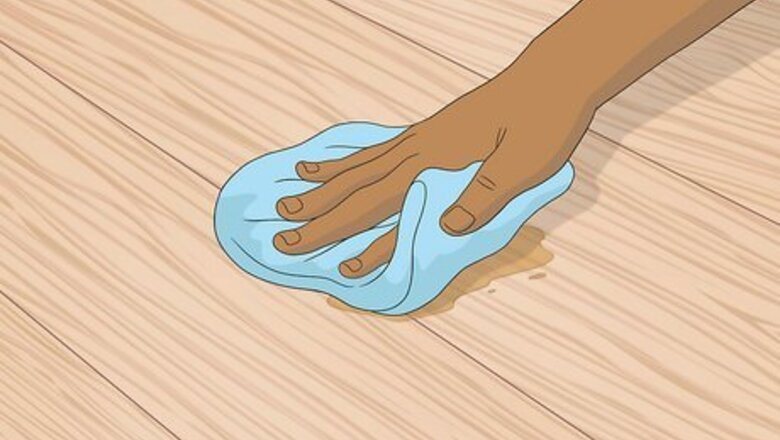
views
- Spread kitty litter or baking soda over the spill ASAP and vacuum it up after at least 30 minutes.
- Froth dish detergent and water in a bowl to make soap suds, then rub just the suds into the stain with a soft cloth.
- Wipe off the suds and excess oil with a soft, damp cloth, then dry it completely.
Cleaning a Fresh Spill
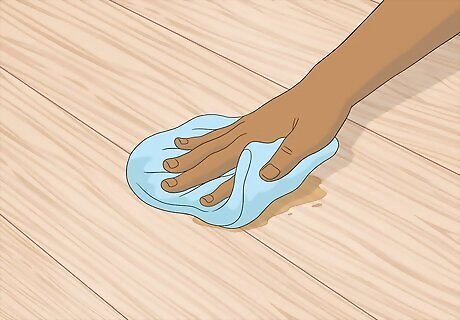
Blot up the oil as quickly as you can. The faster you deal with a spill, the better your chances of getting out the stain. Use a newspaper or soft, absorbent cloth to dab up all the excess oil. Don’t rub, or you could work the oil further into the wood.
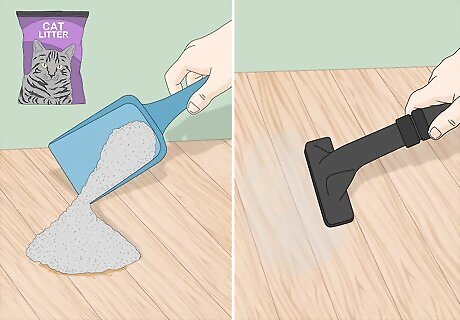
Cover the stain with kitty litter for 30 minutes, then vacuum it up. Next, cover the stain in an inch (2.54 cm) of absorbent powder, like baking soda, kitty litter, or talcum powder. Let it sit for at least 30 minutes or up to overnight, then vacuum it all up. Wear gloves to prevent skin irritation.
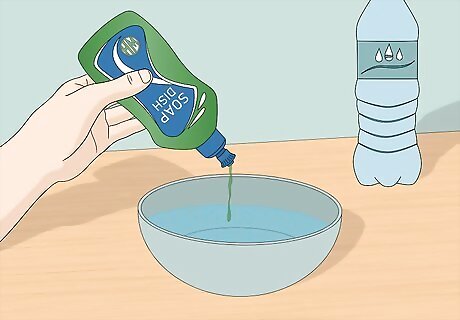
Mix dish soap and water in a bowl. Pour dish detergent into the bottom of a bowl, then fill it with water. Use regular dishwashing detergent or a similar cleaner designed to cut through oil. Mix up the water with your hands to create soap suds. You can also use a pH neutral cleaning agent, like OdoBan, just as long as it's diluted with water. Some people swear by spraying your floor down with a vinegar solution, but using an acidic cleaner on hardwood can damage the finish, so we don't recommend it.
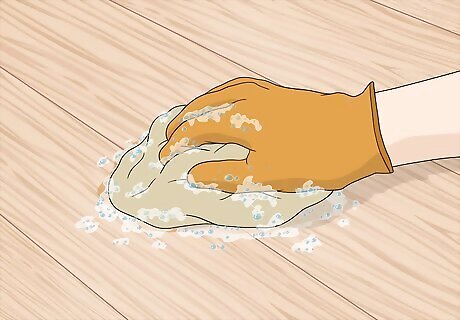
Use a cloth to spread the detergent suds on the stain. Scoop the suds, and not the water, out of the bowl and pour them on the stain. Use a soft cloth or brush to gently work the suds into the wood grain to break down the grease.
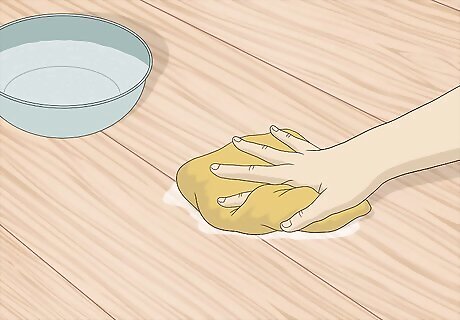
Wipe the soap away with a cloth dipped in clean water. Dip a cloth in cold water, then wring it out. Water can stain wood, so get out as much as you can. Clean up the suds and oil entirely.
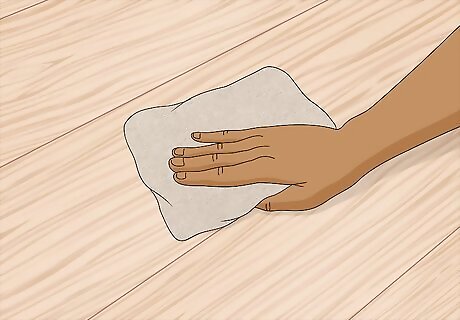
Dry the area with a soft dry cloth. Once the suds are removed, dry the wood gently and thoroughly. Allow the area where the spill was to air dry completely. If possible, open a window or use a fan to speed up the drying process. If the grain of the wood is raised after the floor is completely dry, smooth it with fine sandpaper. If you have a wax-finished floor, gently rub wax over the area with a soft cloth. If you have a surface finish, spread a polyurethane varnish on the floor to refinish it.
Cleaning Older Spills with TSP or Mineral Spirits
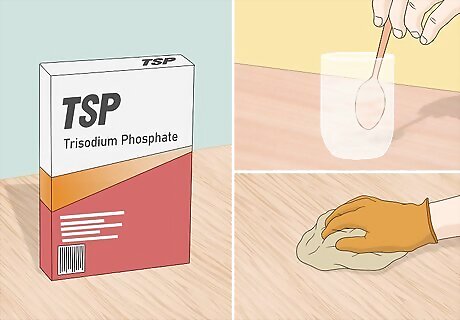
Use TSP on wax-finished floors, and mineral spirits on surface finishes. Scratch a hidden part of your floor with a sharp knife to determine the finish. If clear material flakes up, that’s a wax finish. If no wax beads up, it’s surface finished. If you have a surface-finished floor, use odorless mineral spirits. If it’s wax finished, get trisodium phosphate (TSP). Surface-finished floors have a urethane coating that keeps water from sinking into them. They require a different kind of care than wax-treated floors, because the urethane just sits on top while the wax actually penetrates the wood. If you’re using TSP, mix 1 tablespoon (.17 g) into 32 fluid ounces (950 mL) of water to make a cleaning solution. Use a glass bowl and a wooden stirrer to keep the TSP from reacting with metal.
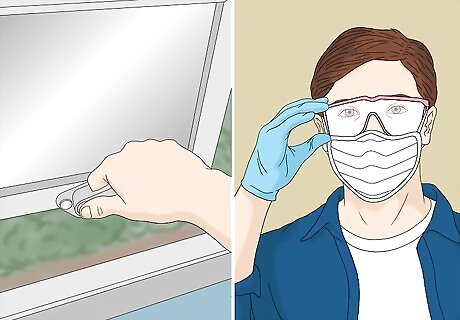
Ventilate the room and put on safety gear. Open a window or use an electric fan to provide airflow through the room, since the fumes from these cleaners are harmful. Put on rubber gloves and a respirator if you’re using mineral spirits, and put on goggles as well if you’re using TSP.
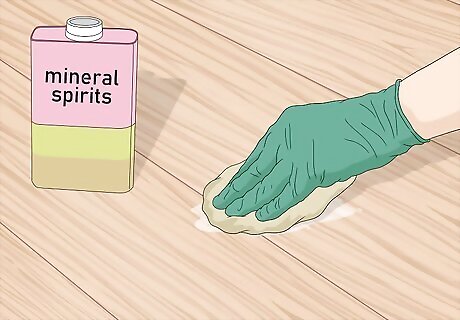
Saturate the stain in the cleaning product. Pour some mineral spirits onto an absorbent cloth, then place it on the stain. After a few minutes, wipe the mineral spirits away and wash the wood with water before completely drying it off. If you’re using TSP, dip a sponge in the mixture and rub down the area with the stain. Dip another sponge in warm water, squeeze it out, and rinse all of the TSP solution off of the floor. If the stain persists, repeat this step.
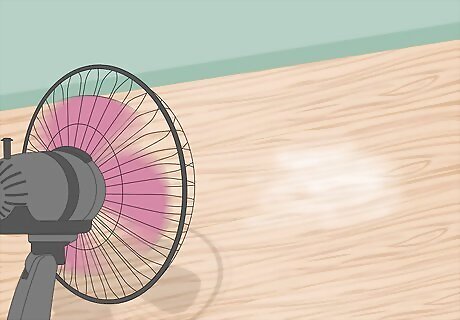
Allow the stained area to air dry. If possible, use a fan or open a window to aid the drying process. Wait until the area is completely dry before proceeding to the next step.
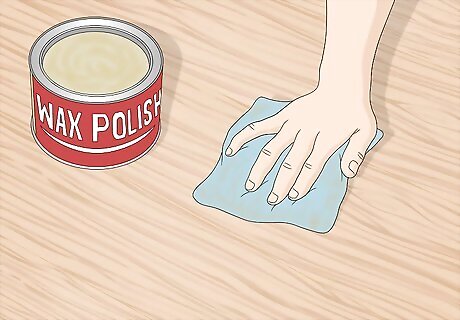
Apply wax or varnish as needed. Squirt a small amount of wax polish onto the affected area and rub it into the wood in a circular motion using a soft cloth. If you have a surface-finished floor, apply a coat of polyurethane and let it dry.
Cleaning Stubborn Stains with Fuller’s Earth
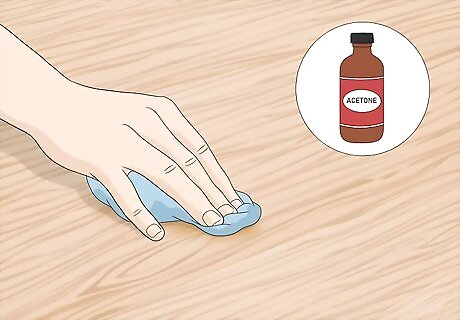
Wipe the floor with acetone. If you have an especially tough stain on a wax-finished floor, use Fuller’s earth to remove it. Wet a rag with a little acetone, then wipe down the area with it. Fuller’s earth is an absorbent powder that mechanics use to clean grease stains off their garage floors. It’s made from the same stuff as kitty litter, but since it’s such a fine powder, it can more easily come in contact with the entire stain.
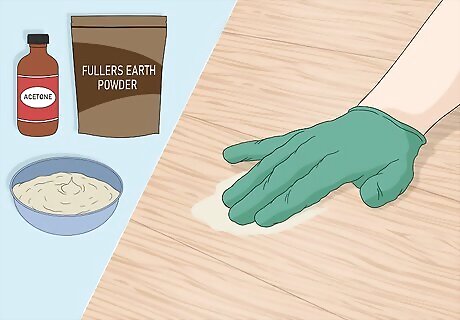
Cover the area with a paste of Fuller’s earth and acetone. Mix a little bit of acetone into Fuller’s earth until it makes a thick paste. Spread the paste on the stain, then let it dry until it turns back into a powder. Make the consistency of the Fuller’s earth between wet sand and clay.
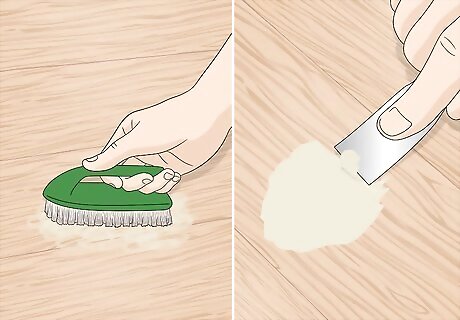
Clear off the Fuller’s earth with a brush or palette knife. Use a clean cloth or a stiff bristled brush to break up the Fuller’s earth, then sweep it up. If it feels stuck, use a palette knife to ease the dried paste off of the floor. Keep repeating this process until the stain is completely gone. Take care not to scratch the floor if you’re using a pallet knife.
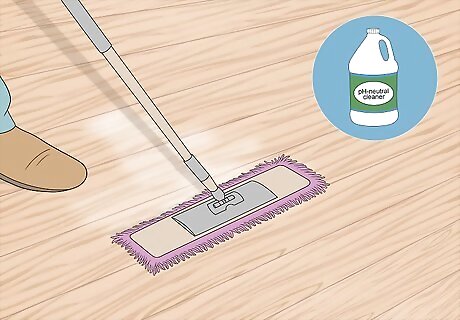
Clean the floor with pH-neutral detergent. Mop the floor using a pH-neutral cleaner for wood floors. This will get rid of any Fuller’s earth residue. Change your mop head as it gets dirty to ensure you’re still picking up residue and not just spreading it around. Flathead mops are great for this because you can easily switch out their heads.
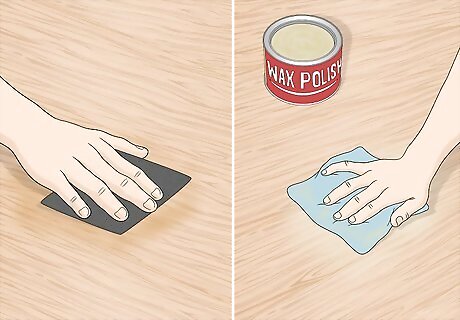
Use sandpaper to gently sand the stained area, as needed. If you can still see oil in the wood grain, carefully sand down the area with fine-grit sandpaper. When you’re done, rub a little bit of wax on the area in a circular motion, until the wood soaks it all up.













Comments
0 comment